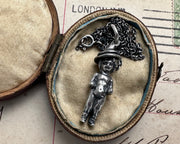Frozen Charlotte pendant - Goody Charlotte - doll necklace charm
With a nod to days gone by, a little sterling silver Frozen Charlotte doll, wearing her conical hat, necklace pendant ... a Goody Charlotte necklace pendant ... historic whimsical doll jewelry.
Back in 17th century Puritan New England Goody was a way to address married older women of a lower social status. It was paired with her surname, for example, Goody Gray with Goody being short for "Goodwife." The men of the same social status were addressed "Goodman" and the terms Goody and Goodman denoted church membership, as those who belonged to the church were “good".
Sadly, there were many "Goody's" in the court records during the horrific witch trials and many were executed. What horrific times they were!
- approximate measurement - 1 1/4" x 3/8” (30mm x 1mm)
- photographed with a US dime for scale
- doll and hat metal - solid sterling silver (.925 silver)
*** goody charlotte charm only - the sterling silver chains are sold separately here
Hand crafted by replicating an antique porcelain Frozen Charlotte doll in wax and carving a little witch hat from a chunk of wax and then had it lost wax cast in sterling silver. The original porcelain frozen charlotte doll is shown in the 4th picture ...she had been unearthed after decades in the ground so her wear and tear is evident on the casting.
Find chains, charm catchers and swivel fobs here.
Find more frozen charlotte jewelry here.
*The original penny dolls were rigid one piece, un-jointed bisque porcelain dolls made during the 19th and early 20th centuries and most were made in Germany. The one inch sized dolls were commonly known as penny dolls or penny babies because they generally sold for one cent. The popularity of the penny dolls can be attributed, in part, to the fact that their relatively low price allowed children to accumulate a collection of dolls with which to play. The tiniest dolls were often used in doll houses and some were even baked in cakes and puddings, hidden as favors or fortunes.
Their sizes ranged from 1” to 18” and the dolls were undressed in a standing position so children would make clothes for them to wear. Some dolls were made by glazing the front but not glazing the back so that they would float on their backs in the tub ... bathing babies.
Now the dolls are commonly known as Frozen Charlottes, after a cautionary tale based on a real event (1840) in which a girl froze to death on the sleigh ride to a winter ball … which sparked a poem by Mrs. Seba Smith (1841)
“A Corpse Going to a Ball” and tells how a young man took Charlotte to a winter ball by sleigh one very cold evening. Charlotte was too proud to wrap up in the blanket and by the time they reached the party she was frozen to death.
Impressed with history!
©2012 suegray jewelry













 Pin it
Pin it